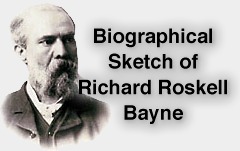

 |
|
|---|---|
|
Richard Roskell Bayne, born in Warwickshire, England, 7 July 1837, received his first training in architecture from his father. In 1858, Bayne worked in the office of the British architect, Charles Barry, while attending classes at University College in London. By 1859, he was studying at the South Kensington School of Design in London, and was awarded the Queen's Prize by that institution in 1860. |
|
After completing a year of travel in Europe, Bayne returned to London where he worked in the office of architect Digby Wyatt. In 1864, he passed the Royal Institute of British Architects Voluntary Architectural Examination, and was also awarded the RIBA Soane Medal. This prize enabled Bayne to make an extensive sketching tour in Europe in 1864-1865. Bayne entered the service of the East India Railway Company on 20 March 1866 and moved to Calcutta. By the time he retired from the Company on 30 April 1890, he had earned the rank of district engineer. After his retirement, he moved to Victoria, B.C., Canada, where he opened an architectural office in May, 1891. He died in Victoria on 4 December 1901, and is buried in the Ross Bay Cemetery.
The Architect and His ProfessionR. R. Bayne's Certificate of Distinction, earned as a result of successful completion of the Royal Institute of British Architects Voluntary Architectural Examination in 1864, marks him as a serious and exceptional student. He was one of the first architectural students in Britain to sit this examination, which consisted of several steps. In order to qualify for the Class of Distinction, the student had to first complete the Class of Proficiency, which included submission of "a measured sketch, a perspective sketch, a drawing of an ornament, and a perspective view with working plans, sections, elevations, and a specification." Once this portfolio was accepted, the student has to sit a written exam featuring seven different subjects: Drawing and Design, History and Literature, Mathematics, Physics, Materials, Construction, and Professional Practice. To achieve a Class of Distinction, the student had to pass the Class of Proficiency exams, submit a portfolio "of more complex measured sketches, drawings from the human figure, subjects of landscape gardening and specimens of modelling and carving." The Distinction Exam included "Languages." Bayne was one of only three students that passed the exams with Distinction in 18 years. His ambition and commitment to learning can be seen in the variety and careful organization of his many sketches. |
© Maltwood Art Museum and Gallery. 1999.
Please send questions & comments to: maltwood@uvic.ca
Web Design: Shehani Kay
Content research: Janice Currier